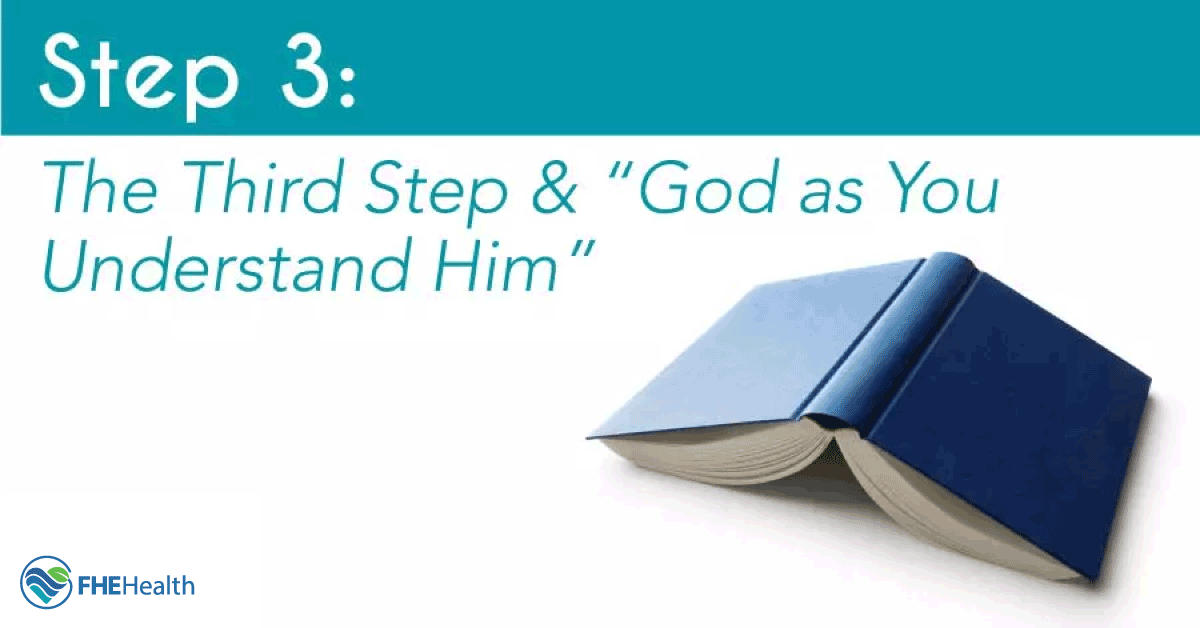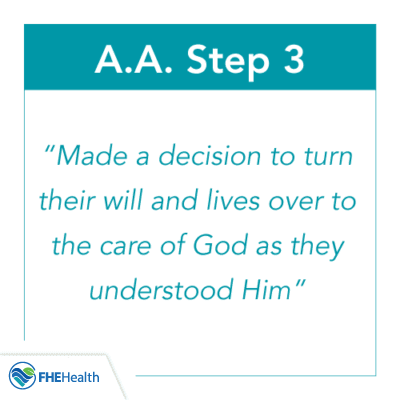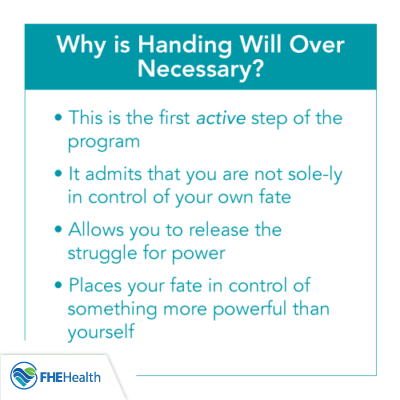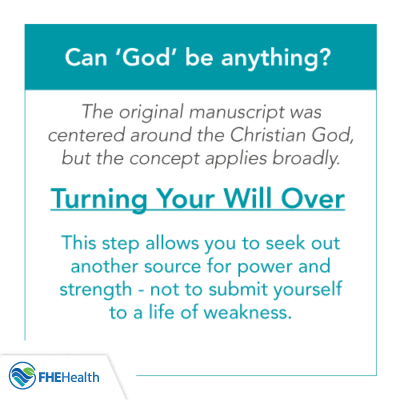
Making a decision to turn life over to a higher power is the third step in the 12 Steps of Alcoholics Anonymous (or Narcotics Anonymous). Specifically, the step calls for participants to “make a decision to turn their will and lives over to the care of God as they understood Him.” But you don’t have to be Christian or submit to the Christian God to take part in AA/NA groups or a treatment program based on the 12 Steps. Examine this step further below to find out what it means to submit to a higher power and what “God as I understand him” actually means.
The Big Picture of Step 3
 Step 3 obviously comes after two other steps. The first two milestones are steps of admission and understanding — they call on individuals to believe in specific facts.
Step 3 obviously comes after two other steps. The first two milestones are steps of admission and understanding — they call on individuals to believe in specific facts.
First, in step one, individuals struggling with addiction admit that the substance they’re addicted to is in control. You can’t regain control if you haven’t yet admitted you’re not in control. It’s also important to define what has been in control so you can work (with support from others) to take your life back from it.
In the second step, individuals come to believe there is a higher power. They don’t have to rely solely on themselves to overcome addiction and take control. They can rely on a power greater than themselves to “restore sanity.”
In a paper published by the National Institutes of Health, Lee Ann Kaskutas, PhD, calls the 12 Steps a program where “faith meets science.” She also notes that the effectiveness of AA in helping individuals stay sober is high. In fact, she reports that abstinence rates are double for those who stick with the 12 Steps than for those who do not take part in them.
There is, apparently, power in submitting to that higher power. Which is what happens in Step 3. Once you acknowledge that you’re not in control and that there is a higher power, you commit to putting that power in control.
Why Is Step 3 Necessary?
 Step 3 is the first active milestone of the 12 Step process. It’s necessary because it’s at this point that a person makes the choice to replace addiction and substances with a higher power.
Step 3 is the first active milestone of the 12 Step process. It’s necessary because it’s at this point that a person makes the choice to replace addiction and substances with a higher power.
While it might sound simple, individuals often struggle with Step 3, especially in modern society. They may have been taught that they are the captain of their fate — that their inevitable success or failure in life rests upon them alone. ‘Will power and positive thought trump all’ is a common mantra today, but those who have come to this point with addiction know that simply isn’t true.
Addiction is often a humbling experience. People who have come to the point of seeking treatment or attending AA/NA meetings know they aren’t the captain of their fate. At that point in their lives, drugs, alcohol, gambling or another addiction has taken control of the helm. And will power and positive thinking alone isn’t usually enough to wrestle back control of your ship.
That’s why Step 3 is important. It offers a chance for individuals to let go of some of this struggle and allow a power greater than them to step in. By surrendering to a higher power, individuals begin to develop a relationship with something that can guide them through the next steps and help them remain drug or alcohol-free long-term.
According to numerous studies, while scientists aren’t always willing to admit causation, there is a definite correlation between the involvement of 12 Step programs and long-term sobriety. Much of that success comes from putting God, as you understand him, in control of your life.
What Is “God as I Understand Him?”
 Many people associate the God of AA with the Christian God. And while many churches do offer space for 12 Step meetings, the steps themselves are not specifically religious in nature. In other words, they aren’t associated with a certain type of faith or church.
Many people associate the God of AA with the Christian God. And while many churches do offer space for 12 Step meetings, the steps themselves are not specifically religious in nature. In other words, they aren’t associated with a certain type of faith or church.
The God in Step 3 is your own personal higher power. If you are Muslim, Christian or Jewish, that may be the God of your religion. But many world religions have higher powers to turn to. And if you aren’t religious in nature, Step 3 simply requires you to decide what higher power you can submit to. In some cases, it’s simply a benevolent universal energy force, for example.
It’s important to know that submitting to your higher power isn’t about wallowing in weakness. It’s about finding strength in something outside of yourself — a strength that never lets you down and is in infinite supply. It’s this strength that many people find creates a bridge to a new life after addiction.
What Does the Third Step Have to Do With Alcohol or Drug Addiction Treatment?
AA and the programs that follow the same model but address other types of addictions don’t consider themselves a treatment modality. While meetings and groups are a proven first-line defense against addiction and substance abuse, they don’t offer specific services such as detox, rehab treatment and the intensive therapy that may be required to get off drugs or alcohol in the first place.
But AA, NA and other 12 Step programs work with and within treatment programs. In many cases, treatment programs are based on the same approaches. They may also prepare individuals to step back into regular life with the 12 Step tools.
It’s important to realize that turning your life over to a higher power isn’t a spell that automatically brings peace and sobriety. Many people still need treatment to help overcome drugs or alcohol, and it’s the higher power that helps you make it through and beyond that treatment.
At FHE Health, caring counselors and clinicians work to help you understand your addiction so you can overcome it. They also help you apply proven approaches, including the 12 Steps, to maintain a drug- and alcohol-free lifestyle long-term. If you’re dealing with addiction, contact us today to speak with an admissions counselor about your options for treatment.
Our 12-Step Series:
- Why the 12-step Program Still Works
- Step 1: Why the 12-step Journey Begins with Powerlessness
- Step 2: What is a Higher Power?
- Step 3: God as you Understand Him
- Step 4: Your Moral Inventory
- Step 5: Admitting Your Wrongs
- Step 6: Addressing Character Defects
- Step 7: Removing our Defects
- Step 8: Willing to Make Amends
- Step 9: Making Amends, How to Approach Step 9
- Step 10: Ongoing Inventory
- Step 11: How to Deepen Your Connection with a Higher Power
- Step 12: Sharing Your Spiritual Awakening With Others
- Understanding AA Lingo
- Understanding the A.A. Preamble
- How to Talk in AA and Group Therapy – An Etiquette Primer






